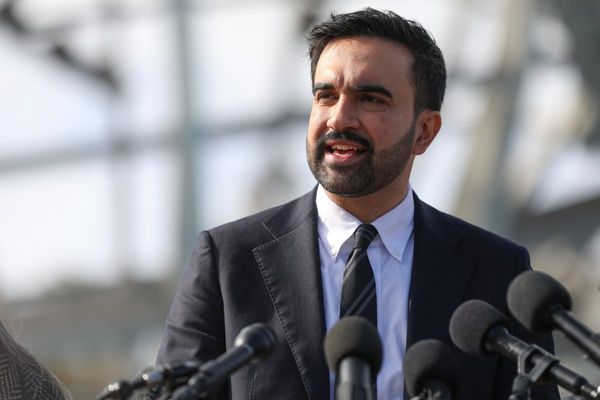
Left punch, right punch. That's what it must feel like to be the electric vehicle tax credit in Washington right now—the House and Senate are both coming after it, and the gloves are off to decide which arm's megabill will rip the $7,500 EV tax credit from the consumer.
Welcome back to Critical Materials, your daily roundup for all things electric and tech in the automotive space.
In today's edition, we get more information about how—and when—the EV tax credit faces the reaper. Plus, used Tesla prices are plummeting while other used vehicles are becoming more valuable and China's EV industry's supply chain is cash-strapped by "hundreds" of days. Let's jump in.
30%: The Clock Is Ticking For The EV Tax Credit

Here we go again, folks. The EV tax credit—America's most sacred carrot for advancing the adoption of electrified vehicles—is on the chopping block.
This time, a new megabill moving through the Senate could kill the clean vehicle credit just 180 days after being signed into law. Essentially, a six-month use-it-or-lose-it notice for consumers and automakers alike. But that's if it passes.
Buried deep within the 549-page bill is the death sentence for the tax credit, extending all the way from the $7,500 credit applied to brand new battery-electric vehicles (for eligible individuals) down to the $4,000 credit for the very specific criteria applicable for used EVs.
The bill text would end the credit 180 days after it was signed into law, assuming it passes in its current form. The EV leasing loophole that allows automakers to apply the tax credit to customers who lease otherwise ineligible vehicles would be ended instantly.
It's worth noting that the House of Representatives also has a proposed bill that would kill the EV tax credit at the end of 2025. However, if an automaker had not yet sold 200,000 EVs, the tax credit would extend through the end of 2026. That bill also has provisions to add a $250 annual fee on EVs. This provision isn't present in the Senate version of the bill.
Now, sure, EVs are gaining popularity. But the biggest issue is that price parity simply isn't there (yet). Automakers are getting close. In fact, the average EV sells for more than $55,000, which is almost 12% higher than the average transaction price of a gas-powered vehicle. If most consumers are presented with the exact same vehicle, but one would cost them over $5,000 more, do you think they'd choose the EV?
The Senate bill would allow consumers who meet certain income and vehicle purchasing limitations to deduct the interest paid from their auto loan. This would result in a $57,000 auto loan at 5% interest actually allowing consumers to deduct more over 60 months than the current EV tax credit provides—however, the key to adoption for most consumers is the lower upfront cost and resulting monthly payment, which is what the current EV tax credit currently provides.
The idea of the tax credit was always to help promote the idea of battery-electric cars. Help consumers buy into and trust the tech while the infrastructure and manufacturing could be built behind the scenes. Meanwhile, automakers could ensure that they received an incentive to stay relevant with the rest of the global industry.
60%: Americans Are Rushing To Buy New Cars Due To Tariffs

If there’s one thing that gets buyers to open up their wallets, it’s FOMO—the Fear of Missing Out. Couple that with a major purchase like a car and that’s when buyers start to churn through an already short supply of cars like it’s some sort of Black Friday sale.
According to a new survey by Cars.com, as reported by Automotive News, more than half of new car shoppers are experiencing a bit of FOMO right now ahead of their next car purchase. Their motivation? Not that cars are in short supply, but the inevitable tariff-related price hikes that brands have been putting off for months.
Automotive News explains:
The survey found 52 percent of in-market car shoppers said they were looking to buy a new vehicle sooner than they otherwise would have because of tariffs. Another 7 percent said they were considering moving faster but were “not rushing,” while 19 percent said they were delaying their purchase to see how tariffs impact vehicle prices.
Just 22 percent of shoppers said tariffs had no impact on their thinking, according to the survey, which was conducted in June. The poll of around 1,000 new-vehicle shoppers was done as part of Cars.com’s annual American-Made Index, which ranks vehicles by their overall impact on the U.S. economy.
It should be no surprise that manufacturers would need to raise prices. Despite U.S. President Donald Trump pledging to pen trade deals with other countries, marques have been preparing for the inevitable for months and eating the tariff-related costs as they could. And to make matters worse, the domestic supply of imported cars is cratering as automakers stall overseas vehicle imports. The domino effect, of course, is a lower supply of new cars on the market, which is driving up the cost of both new and used vehicles—except for Teslas.
The protectionist measures pushed by the federal government will only do so much good. Even if automakers—both foreign and domestic—manage to dodge tariffs by bringing production stateside, U.S.-assembled vehicles are notoriously more expensive than those built elsewhere. According to the study, the average vehicle assembled in the U.S. costs a whopping $53,290. Next up is, surprisingly, China at $50,602, followed by Canada at $46,413, and finally Mexico at $41,885. Cars built in other markets around the globe average out to around $49,527.
It all comes down to a rather ironic paradox. Americans buying a new car will soon need to choose: American-made, or reasonably priced? Tariffs are slowly making the latter impossible, and the dream of a low-priced car seems to be going right out the window.
90%: China's EV Industry Is About To Enter An Industry-Wide Elimination Phase: 'Some Companies Will Die'

China's fierce EV industry is quickly approaching its Hunger Games Era. That means the golden age of EV startups seems like its finally coming to an end for the country.
According to analysts, what's in store for China's automakers is going to be brutal: an industry-wide elimination round where cash-strapped automakers and suppliers are going to get a serious trim. We're not talking about restructuring or pivoting to another sector, but a flat-out "industry-wide elimination phase" that's coming for any brand that isn't in the position to adapt.
This is not uncommon for any auto market. The U.S. went through waves of that throughout the 20th century—RIP to Packard, Hudson, Studebaker and Plymouth—yet China is seeing the accelerated version of that.
With more than 100 automakers on tap in China, a brand crisis was only a matter of time. The big players like BYD, Geely, Nio, Xpeng and so on have carved out some real market share, complete with functional charging infrastructure to back it up. But then there's a huge swath of companies that exist somewhere between Xiaomi on the high end and total vaporware on the lower end. Lesser brands, along with the major suppliers across the industry, are hurting for money.
Apparently, automakers have had a bit of an issue paying their bills on time. Some can blame being strapped for cash, but for others, it's just normal practice and is causing the supplier industry to basically implode.
Bloomberg explains:
Chinese carmakers’ pledge to make timely bill payments — an effort to appease officials’ growing scrutiny of a long-running price war — has left many suppliers skeptical about how readily they’ll follow through on their promises.
After meeting with regulators in early June about the need for better self-regulation, the industry’s biggest names including BYD Co. and Zhejiang Geely Holding Group Co. said they’ll pay suppliers within 60 days. While that represents a shift toward global industry norms, it’s a major change for some carmakers, including BYD, whose payment cycles can stretch to hundreds of days.
[...]
Extended payment terms are such an ingrained feature of the industry that automakers may be motivated to figure out workarounds, according to interviews with parts manufacturers at an auto and supply chain exhibition in Hong Kong last week. That’s put a damper on what many describe as a welcome change, they said, asking not to be identified discussing commercial operations.
One alternative is to issue promissory notes, which delay cash redemption for an additional period, according to a market development engineer from a maker of wiring and electrical parts.
It's not like smaller automakers are the only ones to blame, either. Bloomberg points out that BYD's payments can take hundreds of days to reach a supplier. That's insane—imagine sitting on millions of dollars in invoices and not being able to pay employees or keep the lights on.
China's market is booming, but its overcapacity problem has led to domestic automakers pushing their new inventory onto dealers who are basically begging them to stop. Others are flooding the used market with "zero-mile" cars to offload excess inventory.
These problems, according to the Financial Times, are poised to come to a head very soon:
Yin Xinchi, a car industry analyst at Citic Securities, said a decline in net current assets indicated an increasing rate of cash consumption, with liquidity risks as the numbers turned negative.
“Given the current downward trend, China’s auto industry is expected to enter an industry-wide elimination phase . . . in 2026 at the latest,” he warned. “During the process, some companies will die of liquidity crises.”
Beijing showed its concern about the state of the market last week. In a meeting with 16 major domestic carmakers, government officials issued verbal warnings about aggressive discounting and overdue payments to suppliers, according to two people familiar with the matter. The “zero-mileage” practice of selling brand-new cars as cut-price second-hand vehicles has also been criticised.
If you're wondering what happens next, so are we.
A hundred brands leave a lot of room for failure in a very short period of time. And multiple close up shop at once (as unlikely as it may be), it's a potential game changer for China's biggest brands—and the auto industry as a whole.
Brands may merge, consolidate, or just drop off the face of the earth. Chinese brands have been creating so-called "zombie cars" as automakers quietly bow out, and the potential for thousands more is seen on the horizon by analysts.
100%: How Would The New Senate Bill Affect Your Car Buying Decision?

At this point in the game, it's easier to fantasize about what would happen if the EV tax credit didn't go away, am I right?
It's unfortunate to think that way, but as I'm window shopping EVs in my head, I'm automatically deducting the $7,500 time-of-purchase credit when calculating my monthly payment. I mean, $7,500 is over $140 per month on a 60-month loan at 5% interest. And monthly obligations add up.
So here's where you get to chime in. Does moving the $7,500 EV tax credit make certain EVs unobtainium to you? Is it a smart fiscal move for the government, or a tech-stopping roadblock when America should be facing off against China for EV dominance? Let me know your thoughts in the comments.







